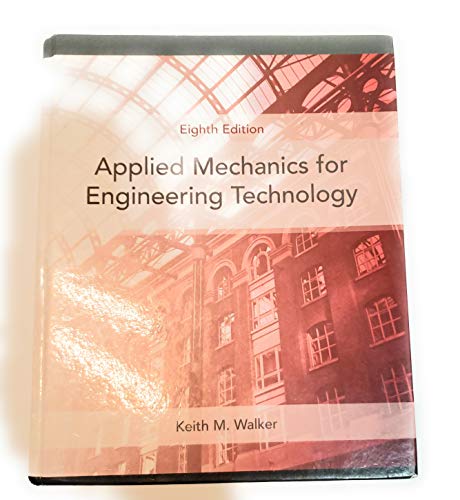
Synopsis
For courses in Applied Mechanics, Statics/Dynamics, or Introduction to Stress Analysis.
Featuring a non-calculus approach, this introduction to applied mechanics text combines a straightforward, readable foundation in underlying physics principles with a consistent method of problem solving. It presents the physics principles in small elementary steps; keeps the mathematics at a reasonable level; provides an abundance of worked examples; and features problems that are as practical as possible without becoming too involved with many extraneous details. This edition features 7% more problems, an enhanced layout and design and a logical, disciplined approach that gives students a sound background in core statics and dynamics competencies.
"synopsis" may belong to another edition of this title.
From the Publisher
Combines theory with practical applications within a direct, readable presentation. Theory is delivered with a few clear statements as each subject is developed through practical examples organized in a systematic format.
Excerpt. © Reprinted by permission. All rights reserved.
Applied mechanics is more than the teaching of physics principles. It is an important instrument in developing a method of stripping a problem to essentials and solving it in a logical, organized manner. This method of working can be applied to many other areas. This book, therefore, shows a consistent pattern of problem solving. The physics principles are presented in small elementary steps, the mathematics is kept at a reasonable level, and the problems are as practical as possible without becoming too involved with many extraneous details.
To accommodate the transition years between the U.S. Customary system and the SI metric system, each chapter is a random mix of both systems but predominantly St metric. There are more than 175 worked examples and 960 graded problems, of which nearly two thirds are in the SI metric system.
I would now like to address the student directly. You will no doubt discover problems that defy solution, no matter how well you understand all previous examples or problems. At the end of each chapter there is a list of hints for problem solving. It is not necessarily a summary of the chapter material but is rather similar to a serviceman's troubleshooting list. It is a list of the common areas where students have had difficulty or made errors in the past. Hopefully, by using this checklist to go back over your diagrams and calculations, you will find self-study and problem solving, not only easier but certainly less frustrating.
I would also like to acknowledge the reviewers of this text: George Tebbetts—University of Arkansas at Little Rock and Alan D. Chamberlain—Point Park College.
Keith M. Walker
"About this title" may belong to another edition of this title.
Search results for Applied Mechanics for Engineering Technology
Applied Mechanics for Engineering Technology
Seller: BooksRun, Philadelphia, PA, U.S.A.
Hardcover. Condition: Fair. 8. The item might be beaten up but readable. May contain markings or highlighting, as well as stains, bent corners, or any other major defect, but the text is not obscured in any way. Seller Inventory # 0131721518-7-1
Applied Mechanics for Engineering Technology
Seller: ThriftBooks-Atlanta, AUSTELL, GA, U.S.A.
Hardcover. Condition: Good. No Jacket. Pages can have notes/highlighting. Spine may show signs of wear. ~ ThriftBooks: Read More, Spend Less. Seller Inventory # G0131721518I3N00
Applied Mechanics for Engineering Technology
Seller: ThriftBooks-Dallas, Dallas, TX, U.S.A.
Hardcover. Condition: Good. No Jacket. Pages can have notes/highlighting. Spine may show signs of wear. ~ ThriftBooks: Read More, Spend Less. Seller Inventory # G0131721518I3N00
Applied Mechanics for Engineering Technology (8th International Edition) ISBN : 9781292027364
International EditionSeller: SellOnline2020, PLAISTOW, NH, U.S.A.
Soft cover. Condition: New. Brand New International Edition textbook. Some book may show sales disclaimer such as "Not for Sale or Restricted in US" on the cover page but it is absolutely legal to use in US or Canada. Ship from Multiple Locations, including Asia , Hong Kong ,Taiwan , US or Canada depend on stock location. Seller Inventory # 000752
Applied Mechanics for Engineering Technology (8th Edition)
Seller: Wrigley Books, Austin, TX, U.S.A.
Hardcover. Condition: very good. Used items may not include media like access codes or CDs. Fast shipping! Expedited orders take 1-3 business days! Media mail may take up to 5 business days. Seller Inventory # 3C-9780131721517-V
Applied Mechanics for Engineering Technology
Seller: Textbooks_Source, Columbia, MO, U.S.A.
hardcover. Condition: Good. 8th Edition. Ships in a BOX from Central Missouri! May not include working access code. Will not include dust jacket. Has used sticker(s) and some writing or highlighting. UPS shipping for most packages, (Priority Mail for AK/HI/APO/PO Boxes). Seller Inventory # 000767696U
Applied Mechanics for Engineering Technology
Seller: Textbooks_Source, Columbia, MO, U.S.A.
hardcover. Condition: New. 8th Edition. Ships in a BOX from Central Missouri! UPS shipping for most packages, (Priority Mail for AK/HI/APO/PO Boxes). Seller Inventory # 000767696N
Applied Mechanics for Engineering Technology (8th Edition)
Seller: Wrigley Books, Austin, TX, U.S.A.
Hardcover. Condition: like new. Used items may not include media like access codes or CDs. Fast shipping! Expedited orders take 1-3 business days! Media mail may take up to 5 business days. Seller Inventory # 3C-9780131721517-L
Applied Mechanics for Engineering Technology (8th Edition)
Seller: Wrigley Books, Austin, TX, U.S.A.
Hardcover. Condition: new. Used items may not include media like access codes or CDs. Fast shipping! Expedited orders take 1-3 business days! Media mail may take up to 5 business days. Seller Inventory # 3C-9780131721517-N
Applied Mechanics for Engineering Technology
Seller: BEST BOOK, Richardson, TX, U.S.A.
hardcover. Condition: New. Ship within 24hrs. 100% Satisfaction is Our #1 Goal! Seller Inventory # 3C3-00014

